-
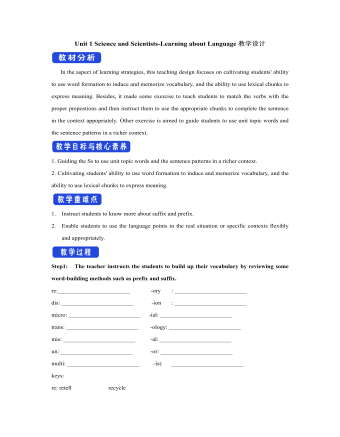
新人教版高中英语选修2Unit 1 Science and Scientists-Learning about Language教学设计
Step 7: complete the discourse according to the grammar rules.Cholera used to be one of the most 1.__________ (fear) diseases in the world. In the early 19th century, _2_________ an outbreak of cholera hit Europe, millions of people died. But neither its cause, 3__________ its cure was understood. A British doctor, John Snow, wanted to solve the problem and he knew that cholera would not be controlled _4_________ its cause was found. In general, there were two contradictory theories 5 __________ explained how cholera spread. The first suggested that bad air caused the disease. The second was that cholera was caused by an _6_________(infect) from germs in food or water. John Snow thought that the second theory was correct but he needed proof. So when another outbreak of cholera hit London in 1854, he began to investigate. Later, with all the evidence he _7_________ (gather), John Snow was able to announce that the pump water carried cholera germs. Therefore, he had the handle of the pump _8_________ (remove) so that it couldn't be used. Through his intervention,the disease was stopped in its tracks. What is more, John Snow found that some companies sold water from the River Thames that __9__________________ (pollute) by raw waste. The people who drank this water were much more likely _10_________ (get) cholera than those who drank pure or boiled water. Through John Snow's efforts, the _11_________ (threaten) of cholera around the world saw a substantial increase. Keys: 1.feared 2.when 3. nor 4.unless 5.that/which 6.infection 7.had gathered 8.removed 9.was polluted 10.to get 11. threat
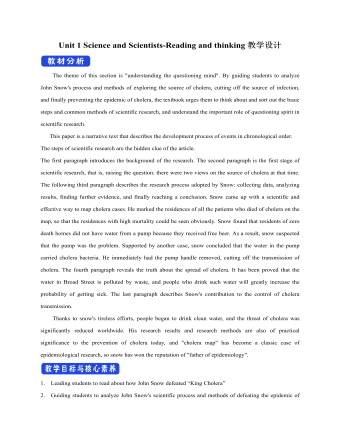
新人教版高中英语选修2Unit 1 Science and Scientists-Reading and thinking教学设计
Step 5: After learning the text, discuss with your peers about the following questions:1.John Snow believed Idea 2 was right. How did he finally prove it?2. Do you think John Snow would have solved this problem without the map?3. Cholera is a 19th century disease. What disease do you think is similar to cholera today?SARS and Covid-19 because they are both deadly and fatally infectious, have an unknown cause and need serious public health care to solve them urgently.keys:1. John Snow finally proved his idea because he found an outbreak that was clearly related to cholera, collected information and was able to tie cases outside the area to the polluted water.2. No. The map helped John Snow organize his ideas. He was able to identify those households that had had many deaths and check their water-drinking habits. He identified those houses that had had no deaths and surveyed their drinking habits. The evidence clearly pointed to the polluted water being the cause.3. SARS and Covid-19 because they are both deadly and fatally infectious, have an unknown cause and need serious public health care to solve them urgently.Step 6: Consolidate what you have learned by filling in the blanks:John Snow was a well-known _1___ in London in the _2__ century. He wanted to find the _3_____ of cholera in order to help people ___4_____ it. In 1854 when a cholera __5__ London, he began to gather information. He ___6__ on a map ___7___ all the dead people had lived and he found that many people who had ___8____ (drink) the dirty water from the __9____ died. So he decided that the polluted water ___10____ cholera. He suggested that the ___11__ of all water supplies should be _12______ and new methods of dealing with ____13___ water be found. Finally, “King Cholera” was __14_____.Keys: 1. doctor 2. 19th 3.cause 4.infected with 5.hit 6.marked 7.where 8.drunk 9.pump 10.carried 11.source 12.examined 13.polluted 14.defeatedHomework: Retell the text after class and preview its language points
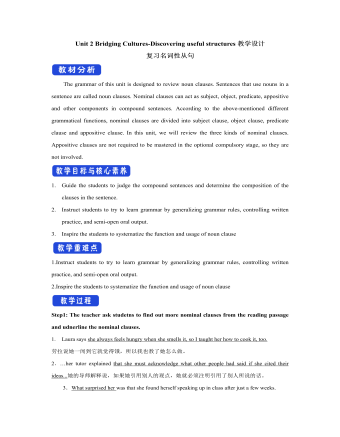
新人教版高中英语选修2Unit 2 Bridging Cultures-Discovering useful structures教学设计
The grammar of this unit is designed to review noun clauses. Sentences that use nouns in a sentence are called noun clauses. Nominal clauses can act as subject, object, predicate, appositive and other components in compound sentences. According to the above-mentioned different grammatical functions, nominal clauses are divided into subject clause, object clause, predicate clause and appositive clause. In this unit, we will review the three kinds of nominal clauses. Appositive clauses are not required to be mastered in the optional compulsory stage, so they are not involved.1. Guide the students to judge the compound sentences and determine the composition of the clauses in the sentence.2. Instruct students to try to learn grammar by generalizing grammar rules, controlling written practice, and semi-open oral output.3. Inspire the students to systematize the function and usage of noun clause1.Instruct students to try to learn grammar by generalizing grammar rules, controlling written practice, and semi-open oral output.2.Inspire the students to systematize the function and usage of noun clauseStep1: The teacher ask studetns to find out more nominal clauses from the reading passage and udnerline the nominal clauses.
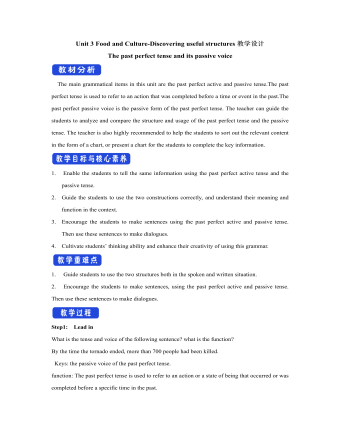
新人教版高中英语选修2Unit 3 Food and Culture-Discovering useful structures教学设计
The newspaper reported more than 100 people had been killed in the thunderstorm.报纸报道说有一百多人在暴风雨中丧生。(2)before、when、by the time、until、after、once等引导的时间状语从句的谓语是一般过去时,以及by、before后面接过去的时间时,主句动作发生在从句的动作或过去的时间之前且表示被动时,要用过去完成时的被动语态。By the time my brother was 10, he had been sent to Italy.我弟弟10岁前就已经被送到意大利了。Tons of rice had been produced by the end of last month. 到上月底已生产了好几吨大米。(3) It was the first/second/last ... time that ...句中that引导的定语从句中,主语与谓语构成被动关系时,要用过去完成时的被动语态。It was the first time that I had seen the night fact to face in one and a half years. 这是我一年半以来第一次亲眼目睹夜晚的景色。(4)在虚拟语气中,条件句表示与过去事实相反,且主语与谓语构成被动关系时,要用过去完成时的被动语态。If I had been instructed by him earlier, I would have finished the task.如果我早一点得到他的指示,我早就完成这项任务了。If I had hurried, I wouldn't have missed the train.如果我快点的话,我就不会误了火车。If you had been at the party, you would have met him. 如果你去了晚会,你就会见到他的。
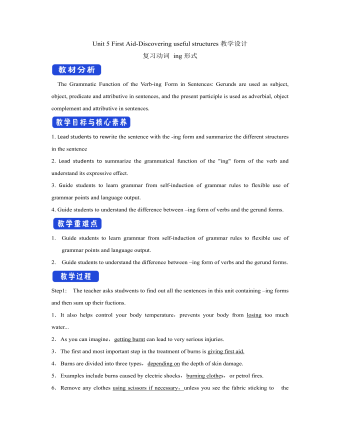
新人教版高中英语选修2Unit 5 First Aid-Discovering useful structures教学设计
You have no excuse for not going.你没有理由不去。He was punished for not having finished his homework.他因未完成作业而受到惩罚。2.动词ing形式复合结构由物主代词或人称代词宾格、名词所有格或普通格加动词ing,即“sb./sb.'s+doing”构成。动词ing形式的复合结构实际上是给动词ing形式加了一个逻辑主语。动词ing形式的复合结构有四种形式:①形容词性物主代词+动词ing②名词所有格+动词ing③代词宾格+动词ing④名词+动词ingHer coming to help encouraged all of us.她来帮忙鼓舞了我们所有人。The baby was made awake by the door suddenly shutting.这个婴儿被突然的关门声吵醒了。Can you imagine him/Jack cooking at home?你能想象他/杰克在家做饭的样子吗?无生命名词无论是作主语还是作宾语都不能用第②种形式。Tom's winning first prize last year impressed me a lot.汤姆去年得了一等奖使我印象深刻。Do you mind my/me/Jack's/Jack leaving now?你介意我/杰克现在离开吗?Excuse me for my not coming on time.很抱歉我没能按时来。His father's being ill made him worried.他父亲病了,他很担心。We are looking forward to the singer's/the singer to give us a concert.我们盼望着这位歌手来给我们举办一场演唱会。

新人教版高中英语必修3Unit 1 Festivals and Celebrations-Reading and Thinking教学设计
The topic of this part is “Discover the reasons for festivals and celebrations.The Listening & Speaking & Talking part aims at talking about the experiences and feelings or emotions about the festivals and celebrations. This section aims at detecting the reason why the people celebrate the festivals, the time, the places, the types and the way of celebrations. It also explains why some traditions in the old celebrations are disappearing, like the firecrackers in the big cities and some new things are appearing like the prosperity of business or commerce. 1. Students can talk about what festivals they know and the reasons and the way of celebrating them.2. Students should learn the reading skills such as the headline and get the topic sentences, the structures of articles.3. Students can understand the past, the present situation of some festival around the world and why there are some changes about them. 4. Students can have the international awareness about the festivals.1. Students should learn the reading skills such as the headline and get the topic sentences, the structures of articles.2. Students can understand the past, the present situation of some festival around the world and why there are some changes about them.Step 1 Lead in---Small talkWhat festival do you like best ? Why ?I like the Spring Festivals because I can set off the fireworks, receive the lucky money and enjoy the Gala with my families.Step 2 Before reading---Pair workWhy do people celebrate different festivals ?The Spring Festivals is to celebrate the end of winter and the coming of spring and new life.The Mid-autumn Day is to celebrate the harvest and admire the moon.
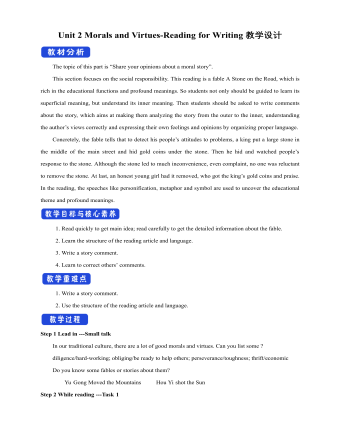
新人教版高中英语必修3Unit 2 Morals and Virtues-Reading for Writing教学设计
1. 这个寓言是一个关于一位国王古寓言。 The fable is an old fable about a king.2.作者用这个故事让读者对于社区的问题负有个人责任的必要印象深刻。The author used the story to impress upon readers with the need to take personal responsibility for problems in the community.3. 这个故事十分成功的实现了它的目的。The story was quite successful in achieving its purpose.Step 7 WritingPlease write a review of the story according the outline above.The fable is an old fable about a king who thought his people are lazy, so he put a large stone in the middle of the road and hides and waited to see if anyone will try to move it.The author used this story to impress upon readers with the need to take personal responsibility for problems in the community. The story was quite successful in achieving its purpose, and I liked it because it had a clear moral.However, while the moral of the story is clear, the actions of the king seemed pointless to me, because none of the characters in the story learnt anything. For this reason, I think there are better stories that can be used to impress upon people with the need for personal responsibility.Step 8 Pair workExchange drafts with a partner. Use this checklist to help your partner revise his/her draft.1. Does the writer give a short description of the story ?2. Does the description include the most important details of the story ?3. Does the writer give his or her opinion about the character or their actions ?4. Is the review well-organised ? 5. Does the writer use the -ing form as the adverbial correctly in the writing ?6. Are there any grammar, spelling, or punctuation errors ?Step 9 HomeworkPut up your revised draft in the classroom or read it to your class.
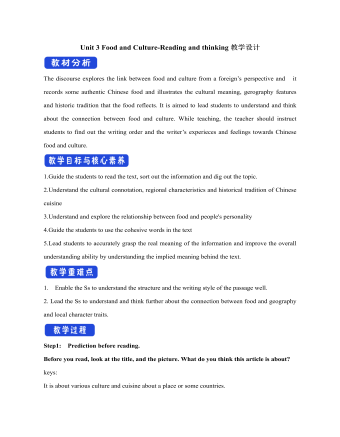
新人教版高中英语选修2Unit 3 Food and Culture-Reading and thinking教学设计
The discourse explores the link between food and culture from a foreign’s perspective and it records some authentic Chinese food and illustrates the cultural meaning, gerography features and historic tradition that the food reflects. It is aimed to lead students to understand and think about the connection between food and culture. While teaching, the teacher should instruct students to find out the writing order and the writer’s experieces and feelings towards Chinese food and culture.1.Guide the students to read the text, sort out the information and dig out the topic.2.Understand the cultural connotation, regional characteristics and historical tradition of Chinese cuisine3.Understand and explore the relationship between food and people's personality4.Guide the students to use the cohesive words in the text5.Lead students to accurately grasp the real meaning of the information and improve the overall understanding ability by understanding the implied meaning behind the text.1. Enable the Ss to understand the structure and the writing style of the passage well.2. Lead the Ss to understand and think further about the connection between food and geography and local character traits.Step1: Prediction before reading. Before you read, look at the title, and the picture. What do you think this article is about?keys:It is about various culture and cuisine about a place or some countries.
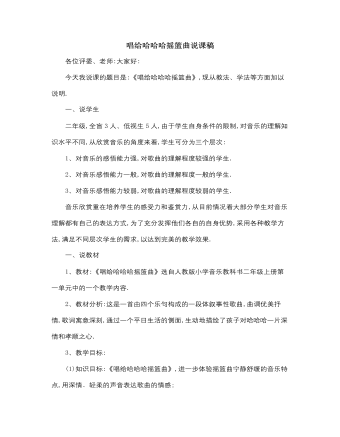
人音版小学音乐三年级上册唱给哈哈哈摇篮曲说课稿
(4)演一演视障生由于生理缺陷,在他们的头脑中很难形成动作形体概念,用情景教学法,使学生身临其境,要求他们不一定按歌曲要求的动作表现,只需要他们把那种对音乐的理解用自己的方式表现出来,边听音乐边表演.通过这样的训练,提高学生的肢体语言能力,同时能大胆发挥想象,做自己对音乐理解的动作,通过动作使其更深刻的理解歌曲.对于低视生让他们通过看课件及对歌曲的理解,创遍简单的舞蹈动作,使其与歌曲的情节相融合,更深刻的体味歌曲内涵.(5)复听歌曲一遍让学生仔细的听乐曲,感受乐曲所带给的独特感受,让他们融入到乐曲中,展开想象,发展他们的空间想象力和创造力,同时提高他们的鉴赏水平.六、课堂小结感谢从小养育我们的父母;感谢一直关心着我们的父母;感谢为我们而操劳的父母……要感谢的太多太多了,就让我们怀着一颗感恩的心,报答我们的父母吧!
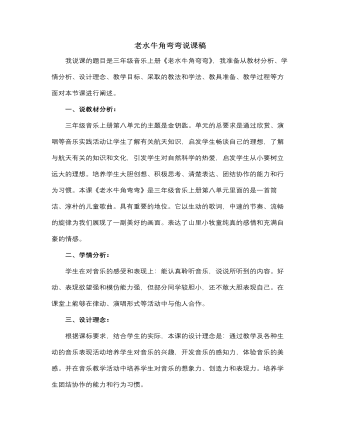
人音版小学音乐三年级上册老水牛角弯弯说课稿
一个情境:“歌中的小牧童把牛背当成了飞船,想象着长大后成为宇航员的样子。同学们,如果你骑在牛背上,双手握着方向盘的时候,你会想到了什么?”学生就能很快地联想到开汽车、开飞机等。再引导他们把想法替换到歌词中唱一唱。这一学习方式不仅为学生创设了民主、宽松、自由的氛围,更激发了学生的创新思维,增强了自信心。4.我利用学生好动、表现欲望强和模仿能力强的特点,鼓励学生根据歌曲创编简单的动作进行表演,并和他们一起表演,从而拉近了师生的距离,激发了学生的学习兴趣,学生的学习积极性也得到充分的调动。第五环节:欣赏图片拓展知识这一环节主要是让学生了解有关航天知识,拓宽学生的文化视野,提高学生的人文素养。引发学生对自然科学的热爱,启发学生从小要树立远大的理想。第六环节:总结全课升华情感鼓励学生从小树立远大的理想,努力学习、用于探索,以实现美好的理想。小结:以上是本课的总阐述,不到之处请指正
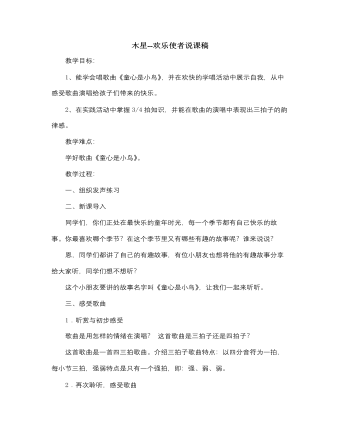
人音版小学音乐六年级上册木星-欢乐使者说课稿
(1)在聆听时注意跟着细声的哼唱,再次感受歌曲的情绪,感受四三拍的特点。(2)注意观察歌词,看看歌曲描写的是哪些季节。这些呢都是这个小朋友的快乐童年,小朋友说他想将他的快乐童年分享给我们,同学们愿意接受吗?四、学习歌曲 1、好,让我们一起来分享这个朋友的快乐童年,请同学们跟老师有感情的朗诵歌词。(边打拍子,边读歌词)同学们,通过刚刚的聆听和现在对歌词的朗读,你认为歌曲可分为几部分?歌曲可以分为两部分,第一部分、第二部分。2、跟琴学唱歌曲。第一部分要表达出喜悦、自豪的心情,声音要轻盈有弹性;第二部分歌词注意欢快的情绪,声音要舒展、连贯。3、完整演唱乐曲。五、课堂小结最后,让我们随着优美的音乐,为我们的童心插上小鸟的翅膀,一起唱起来,跳起来,飞进大自然的怀抱中。
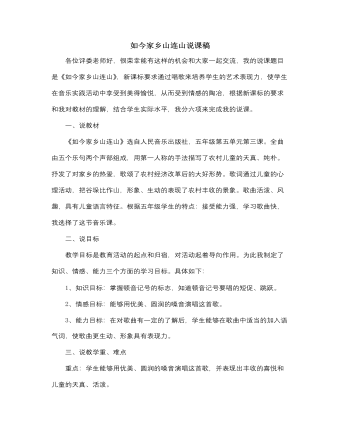
人音版小学音乐三年级上册如今家乡山连山说课稿
3、拓展要求:在学生对歌曲有了一定的了解之后,我会让学生在歌词中适当的地方加入语气词,使歌曲更生动、形象。例如:“妈妈告诉我,家乡没有山”这句歌词,显得有点惋惜和遗憾之情,我觉得用“唉”比较好,下面的就分组讨论。每小组派一个代表唱出自己组里填的语气词。在所有组里的语气词里选一组最好的,确定下来。全班一起演唱,并加上确定的语气词。唱歌比赛:将学生分4个组,一组高声部、一组低声部、一组加语气词、一组加打击乐器(如沙锤、双响筒、碰玲),增强他们的合作意识和合作默契。4、小结在课堂小结时我先安排了学生谈一谈这节课的感想,如:这节课你学到了什么?歌曲中你最喜欢那一句?而且对那些有创意的学生我还及时的发给他们小奖品。在本课的教学中我以表扬和鼓励为主,随时引导学生在音乐活动中开展自评互评和老师的随堂评价,以提高学生的乐感和审美能力。
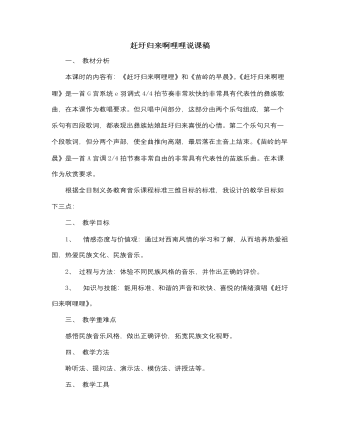
人音版小学音乐六年级上册赶圩归来啊哩哩说课稿
我使用的是聆听法和提问法。请同学们带着这样的问题欣赏《苗岭的早晨》。问题是“听这首乐曲时你眼前浮现的是什么样的画面?这首乐曲表达了怎样的思想感情?”听完后作答。我这样设计的目的是实现我的第二点教学目标。这个环节完后我接着对苗族的重要节日、服饰、音乐、乐器和一些风俗习惯等进行阐述。运用讲授法和讨论法。这样设计的目的是实现我的第一点教学目标。3、 教唱部分:(18分钟)不同的少数民族,他会具有自己独特的民族文化和音乐风格。让我们一起来学习一首很有魅力的彝族歌曲《赶圩归来啊哩哩》。首先我们完整地听一遍,感受一下这首曲子的情绪和独特的地方。接着就是教唱和演唱、分组演唱的部分。这样设计的目的是实现我的第三点教学目标。4、 小结:“今天我们叩开了西南风情的大门,发现里面绚丽多彩如诗如画。希望同学们通过网络和书籍等手段继续参观和探索里面的奥妙。”这样设计的目的是让同学们继续学习。最后结束本课。
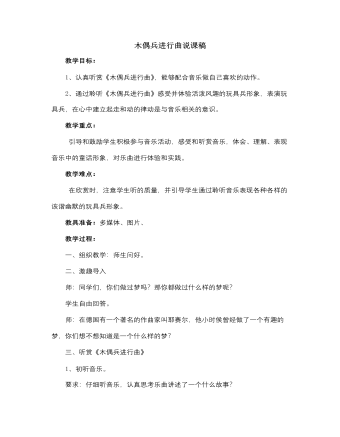
人音版小学音乐六年级上册木偶兵进行曲说课稿
学生模仿玩具兵排着整齐的队伍,挺胸抬头走路的神气样子。(2)欣赏B段,播放课件。师:正当玩具兵们玩的兴高采烈的时候,又发生什么事儿呢?学生描述B段音乐,学生表演故事情节。师:你能模仿玩具们是怎样跳舞和玩耍的吗?学生模仿其他玩具唱歌跳舞和玩耍的样子。(3)欣赏C段,播放课件。师:大家刚才玩的那么高兴,为什么突然都不见了呢?学生通过看课件回答老师的问题。师:小主人醒了,玩具们惊慌失措的逃回了玩具箱。惊慌失措是什么样子?大家能不能表演这段?随音乐表演本段。学生表演惊慌失措的样子和“逃”回玩具箱的动作。4、随音乐集体表演。老师讲述故事并及时提示大家进行完整表演。四:课堂小结。师:这节课我们听赏了这首好听的《木偶兵进行曲》,还玩了玩具兵的游戏。你开心吗?如果很开心,就让我们象玩具兵那样神气的走出教室好吗?
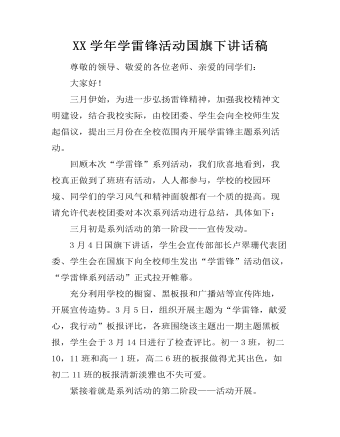
XX学年学雷锋活动国旗下讲话稿
尊敬的领导、敬爱的各位老师、亲爱的同学们:大家好!三月伊始,为进一步弘扬雷锋精神,加强我校精神文明建设,结合我校实际,由校团委、学生会向全校师生发起倡议,提出三月份在全校范围内开展学雷锋主题系列活动。回顾本次“学雷锋”系列活动,我们欣喜地看到,我校真正做到了班班有活动,人人都参与,学校的校园环境、同学们的学习风气和精神面貌都有一个质的提高。现请允许代表校团委对本次系列活动进行总结,具体如下:三月初是系列活动的第一阶段——宣传发动。3月4日国旗下讲话,学生会宣传部部长卢翠珊代表团委、学生会在国旗下向全校师生发出“学雷锋”活动倡议,“学雷锋系列活动”正式拉开帷幕。充分利用学校的橱窗、黑板报和广播站等宣传阵地,开展宣传造势。3月5日,组织开展主题为“学雷锋,献爱心,我行动”板报评比,各班围绕该主题出一期主题黑板报,学生会于3月14日进行了检查评比。初一3班,初二10,11班和高一1班,高二6班的板报做得尤其出色,如初二11班的板报清新淡雅也不失可爱。
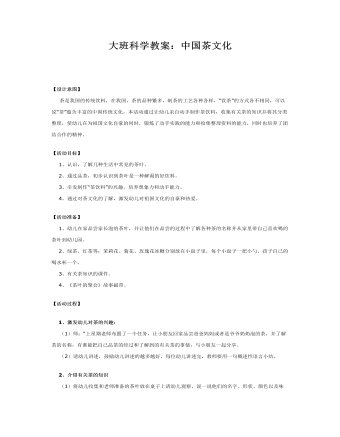
大班科学教案:中国茶文化
【活动目标】 1、认识,了解几种生活中常见的茶叶。 2、通过品茶,初步认识到茶叶是一种解渴的好饮料。 3、引发制作“茶饮料”的兴趣,培养想象力和动手能力。 4、通过对茶文化的了解,激发幼儿对祖国文化的自豪和热爱。【活动准备】 1、幼儿在家品尝家长泡的茶叶,并让他们在品尝的过程中了解各种茶的名称并从家里带自己喜欢喝的茶叶到幼儿园。 2、绿茶、红茶等:茉莉花、菊花、玫瑰花冰糖分别放在小盘子里,每个小盘子一把小勺、孩子自己的喝水杯一个。 3、有关茶知识的课件。 4、《茶叶的聚会》故事磁带。【活动过程】 1、激发幼儿对茶的兴趣: (1)师:“上星期老师布置了一个任务,让小朋友回家品尝爸爸妈妈或者是爷爷奶奶泡的茶,并了解茶的名称,有谁能把自己品茶的经过和了解到的有关茶的事情,与小朋友一起分享。 (2)请幼儿讲述,鼓励幼儿讲述的越多越好,每位幼儿讲述完,教师要用一句概述性语言小结。
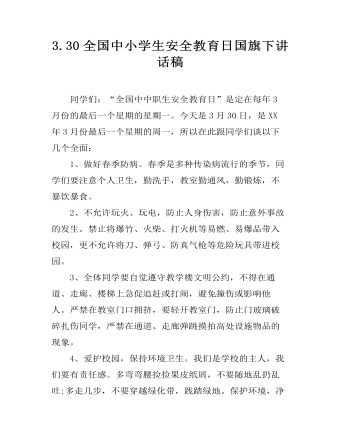
3.30全国中小学生安全教育日国旗下讲话稿
同学们:“全国中中职生安全教育日”是定在每年3月份的最后一个星期的星期一。今天是3月30日,是XX年3月份最后一个星期的周一,所以在此跟同学们谈以下几个全面:1、做好春季防病。春季是多种传染病流行的季节,同学们要注意个人卫生,勤洗手,教室勤通风,勤锻炼,不暴饮暴食。2、不允许玩火、玩电,防止人身伤害,防止意外事故的发生。禁止将爆竹、火柴、打火机等易燃、易爆品带入校园,更不允许将刀、弹弓、防真气枪等危险玩具带进校园。
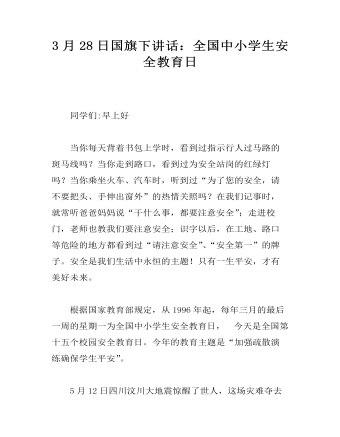
3月28日国旗下讲话:全国中小学生安全教育日
同学们:早上好当你每天背着书包上学时,看到过指示行人过马路的斑马线吗?当你走到路口,看到过为安全站岗的红绿灯吗?当你乘坐火车、汽车时,听到过“为了您的安全,请不要把头、手伸出窗外”的热情关照吗?在我们记事时,就常听爸爸妈妈说“干什么事,都要注意安全”;走进校门,老师也教我们要注意安全;识字以后,在工地、路口等危险的地方都看到过“请注意安全”、“安全第一”的牌子。安全是我们生活中永恒的主题!只有一生平安,才有美好未来。根据国家教育部规定,从1996年起,每年三月的最后一周的星期一为全国中小学生安全教育日, 今天是全国第十五个校园安全教育日。今年的教育主题是“加强疏散演练确保学生平安”。5月12日四川汶川大地震惊醒了世人,这场灾难夺去了整整几万人的生命。在这场灾难中多少家庭支离破碎,多少亲人生死离别。也许有些同学说地震毕竟发生的概率小,那么我就说说我们身边最近发生的一些事吧。
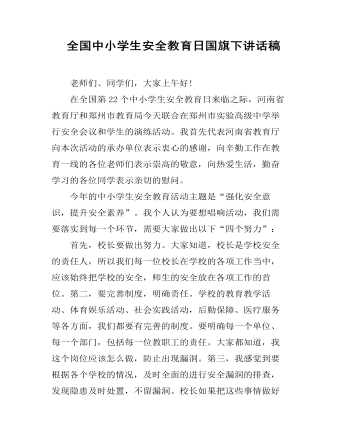
全国中小学生安全教育日国旗下讲话稿
老师们、同学们,大家上午好!在全国第22个中小学生安全教育日来临之际,河南省教育厅和郑州市教育局今天联合在郑州市实验高级中学举行安全会议和学生的演练活动。我首先代表河南省教育厅向本次活动的承办单位表示衷心的感谢,向辛勤工作在教育一线的各位老师们表示崇高的敬意,向热爱生活,勤奋学习的各位同学表示亲切的慰问。今年的中小学生安全教育活动主题是“强化安全意识,提升安全素养”。我个人认为要想唱响活动,我们需要落实到每一个环节,需要大家做出以下“四个努力”:首先,校长要做出努力。大家知道,校长是学校安全的责任人,所以我们每一位校长在学校的各项工作当中,应该始终把学校的安全,师生的安全放在各项工作的首位。第二,要完善制度,明确责任。学校的教育教学活动、体育娱乐活动、社会实践活动,后勤保障、医疗服务等各方面,我们都要有完善的制度。要明确每一个单位、每一个部门,包括每一位教职工的责任。大家都知道,我这个岗位应该怎么做,防止出现漏洞。第三,我感觉到要根据各个学校的情况,及时全面的进行安全漏洞的排查,发现隐患及时处置,不留漏洞。校长如果把这些事情做好了,可以说,我们就是一个比较安全的校园,我们的责任就尽到了。
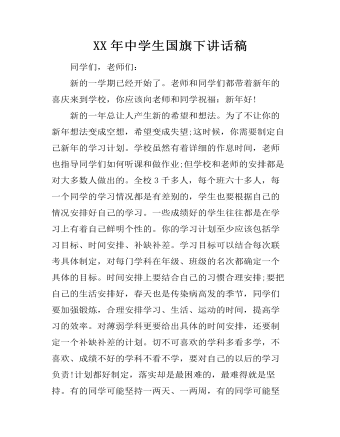
XX年中学生国旗下讲话稿
同学们,老师们:新的一学期已经开始了。老师和同学们都带着新年的喜庆来到学校,你应该向老师和同学祝福:新年好!新的一年总让人产生新的希望和想法。为了不让你的新年想法变成空想,希望变成失望;这时候,你需要制定自己新年的学习计划。学校虽然有着详细的作息时间,老师也指导同学们如何听课和做作业;但学校和老师的安排都是对大多数人做出的。全校3千多人,每个班六十多人,每一个同学的学习情况都是有差别的,学生也要根据自己的情况安排好自己的学习。一些成绩好的学生往往都是在学习上有着自己鲜明个性的。你的学习计划至少应该包括学习目标、时间安排、补缺补差。学习目标可以结合每次联考具体制定,对每门学科在年级、班级的名次都确定一个具体的目标。时间安排上要结合自己的习惯合理安排;要把自己的生活安排好,春天也是传染病高发的季节,同学们要加强锻炼,合理安排学习、生活、运动的时间,提高学习的效率。

